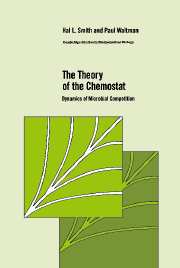Book contents
- Frontmatter
- Contents
- Preface
- 1 The Simple Chemostat
- 2 The General Chemostat
- 3 Competition on Three Trophic Levels
- 4 The Chemostat with an Inhibitor
- 5 The Simple Gradostat
- 6 The General Gradostat
- 7 The Chemostat with Periodic Washout Rate
- 8 Variable-Yield Models
- 9 A Size-Structured Competition Model
- 10 New Directions
- 11 Open Questions
- Appendices
- References
- Author index
- Subject index
8 - Variable-Yield Models
Published online by Cambridge University Press: 07 December 2009
- Frontmatter
- Contents
- Preface
- 1 The Simple Chemostat
- 2 The General Chemostat
- 3 Competition on Three Trophic Levels
- 4 The Chemostat with an Inhibitor
- 5 The Simple Gradostat
- 6 The General Gradostat
- 7 The Chemostat with Periodic Washout Rate
- 8 Variable-Yield Models
- 9 A Size-Structured Competition Model
- 10 New Directions
- 11 Open Questions
- Appendices
- References
- Author index
- Subject index
Summary
Introduction
In the classical model of the chemostat, discussed in Chapter 1, it is assumed (following Monod [Mo1; Mo2]) that the nutrient uptake rate is proportional to the reproductive rate. The constant of proportionality, which converts units of nutrient to units of organism, is called the yield constant. As a consequence of the assumed constant value of the yield, the classical model is sometimes referred to as the “constant-yield” model.
In phytoplankton ecology, it has long been known that the yield is not constant and that it can vary depending on the growth rate [D1]. This led to the formulation of the variable-yield model, also called the variable-internal-stores model [G1] and the Caperon-Droop model [CN1]. This model effectively decouples specific growth rate from external nutrient concentration by introducing an intracellular store of nutrient. The specific growth rate is hypothesized to depend on a quantity, called the cell quota, which may be viewed as the average amount of stored nutrient in each cell of the particular organism in the chemostat. The cell quota increases with nutrient uptake and decreases with cell division, which acts to spread the total stored nutrient over more cells. The uptake rate is assumed to depend on the ambient nutrient concentration and, perhaps, the cell quota.
- Type
- Chapter
- Information
- The Theory of the ChemostatDynamics of Microbial Competition, pp. 182 - 207Publisher: Cambridge University PressPrint publication year: 1995



